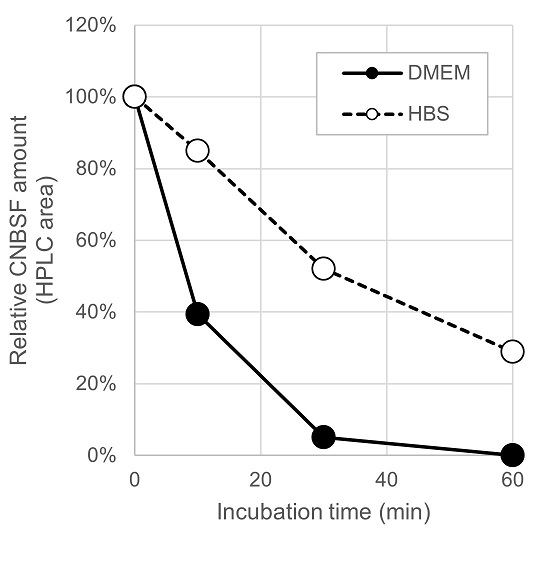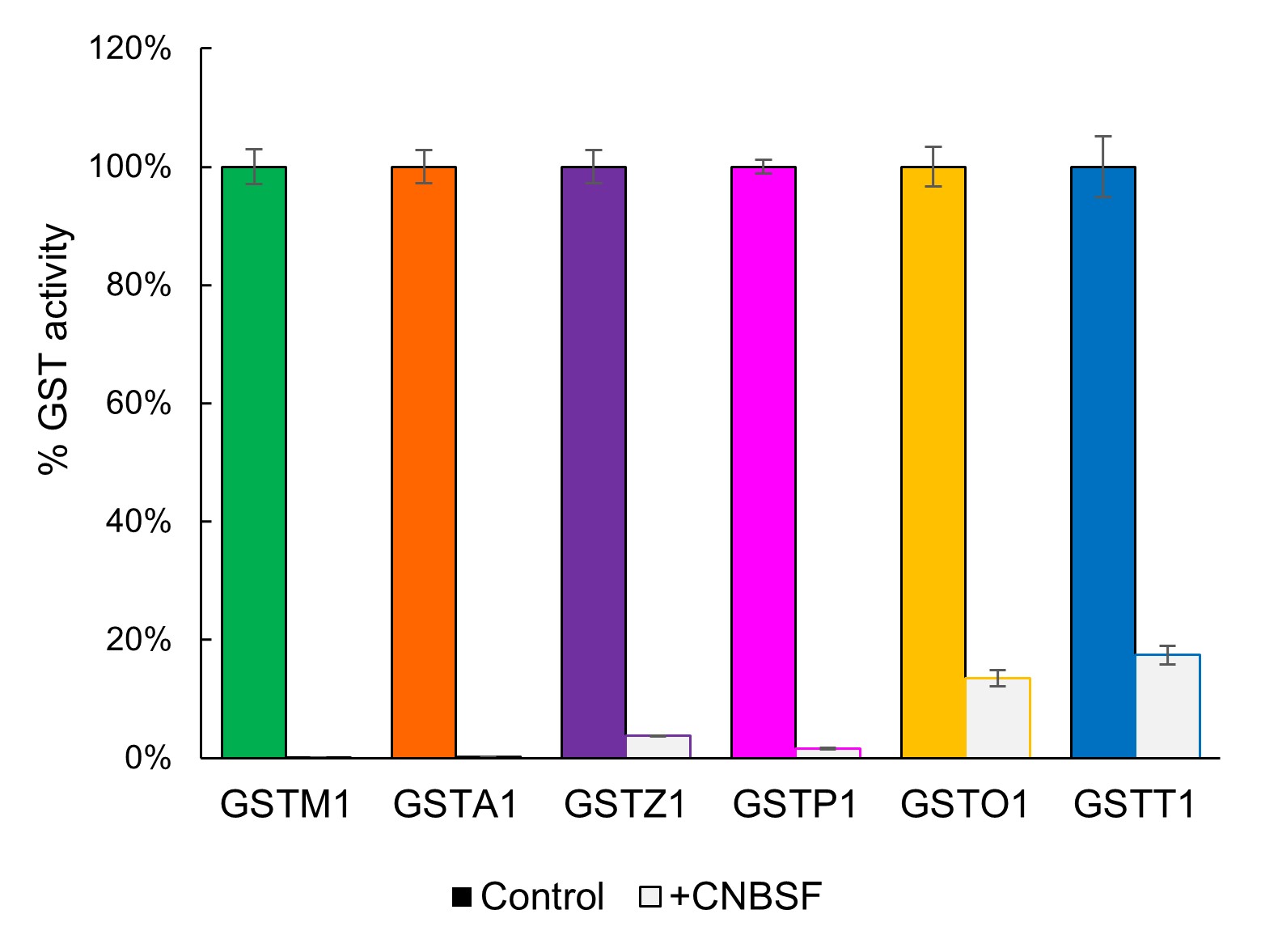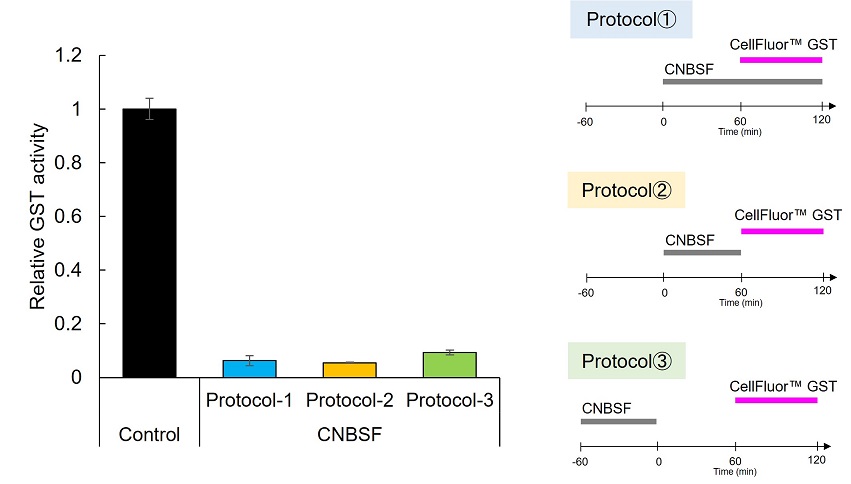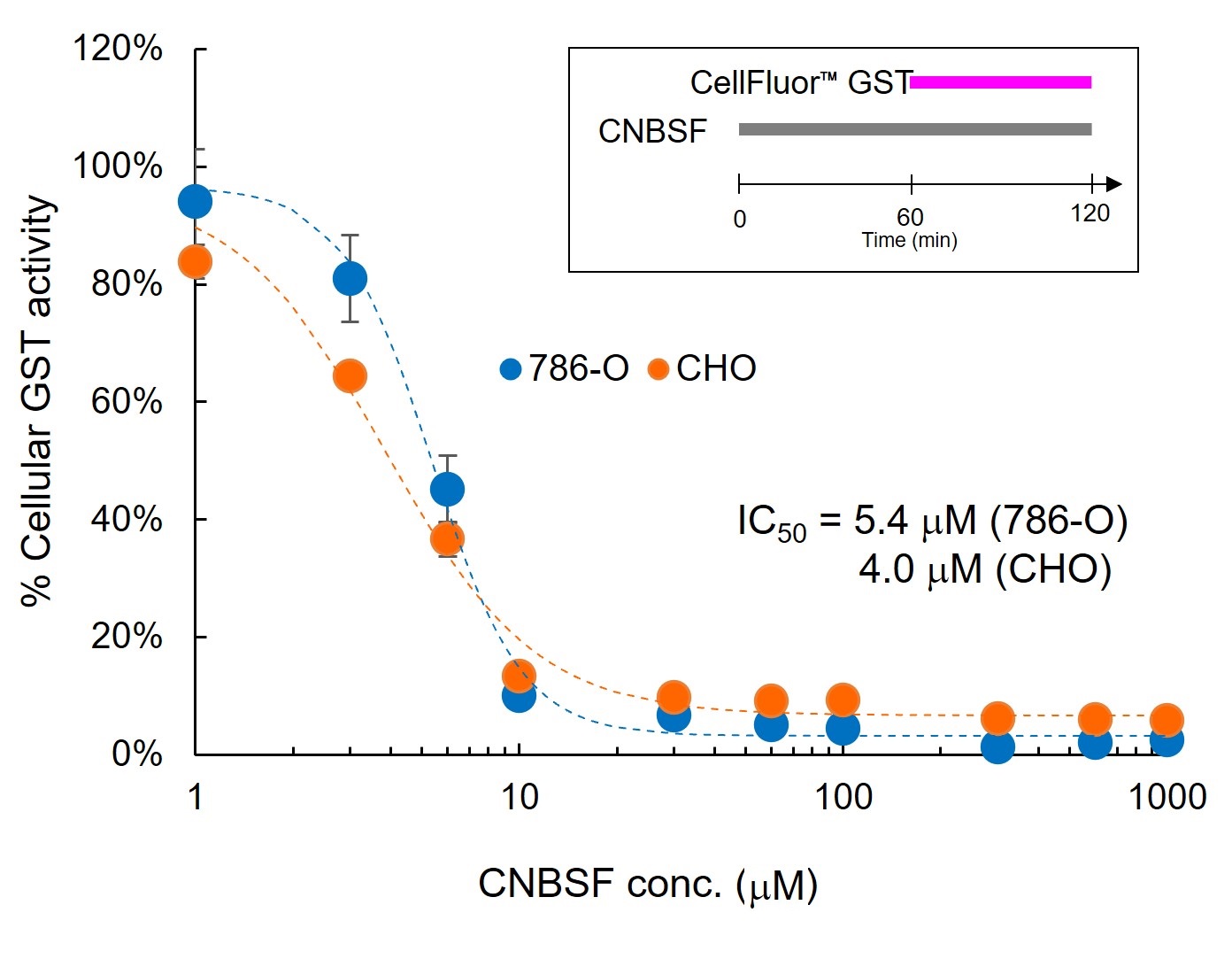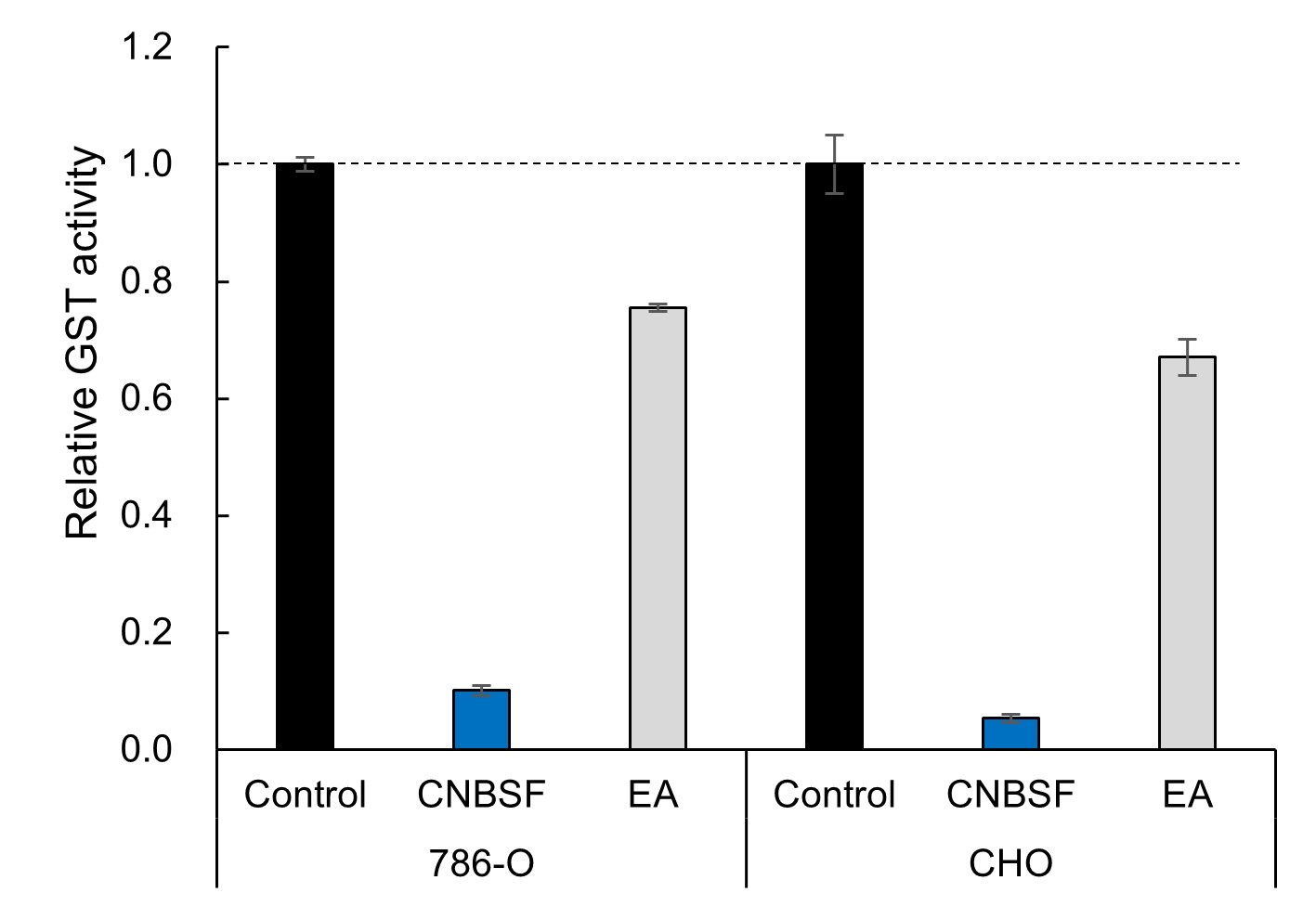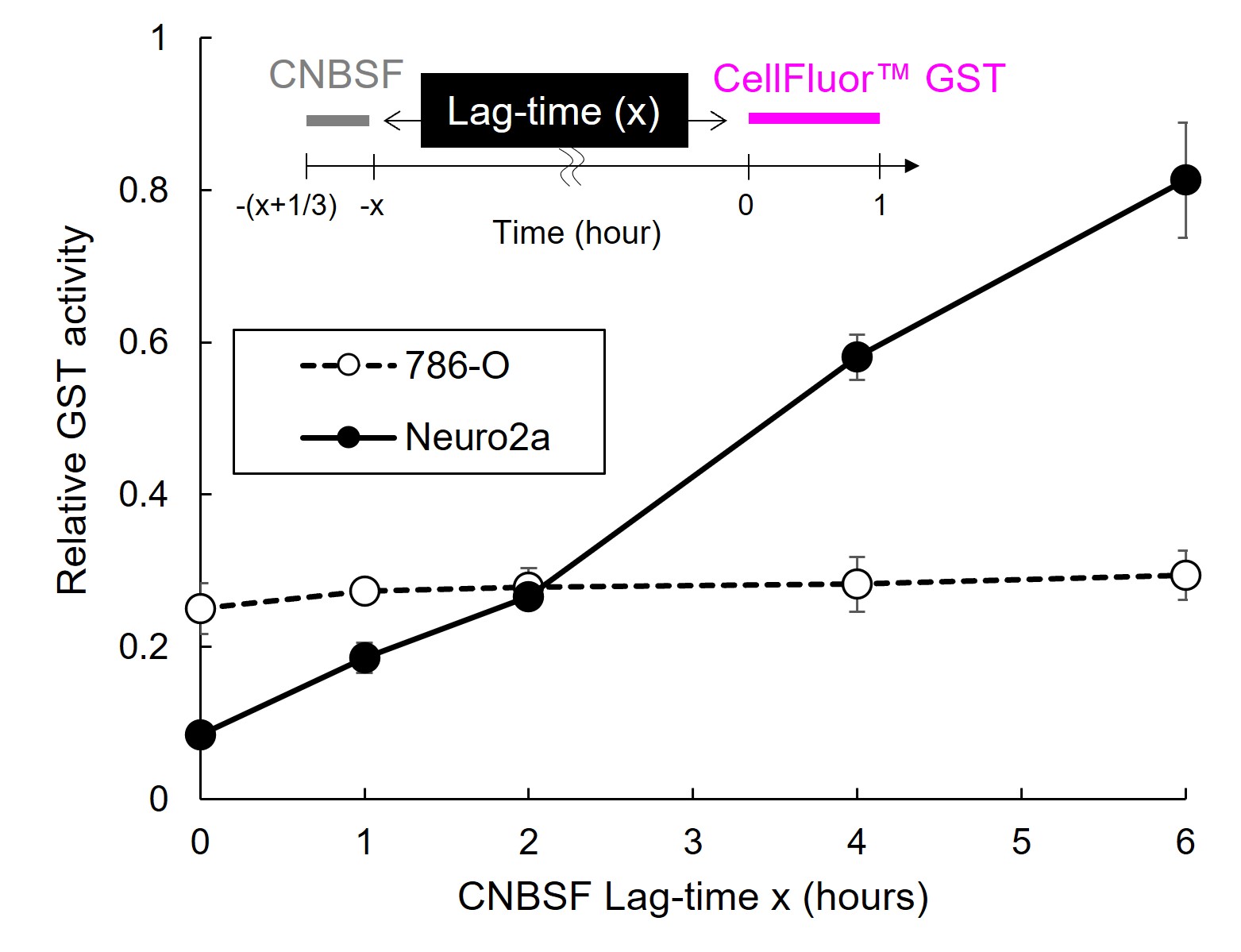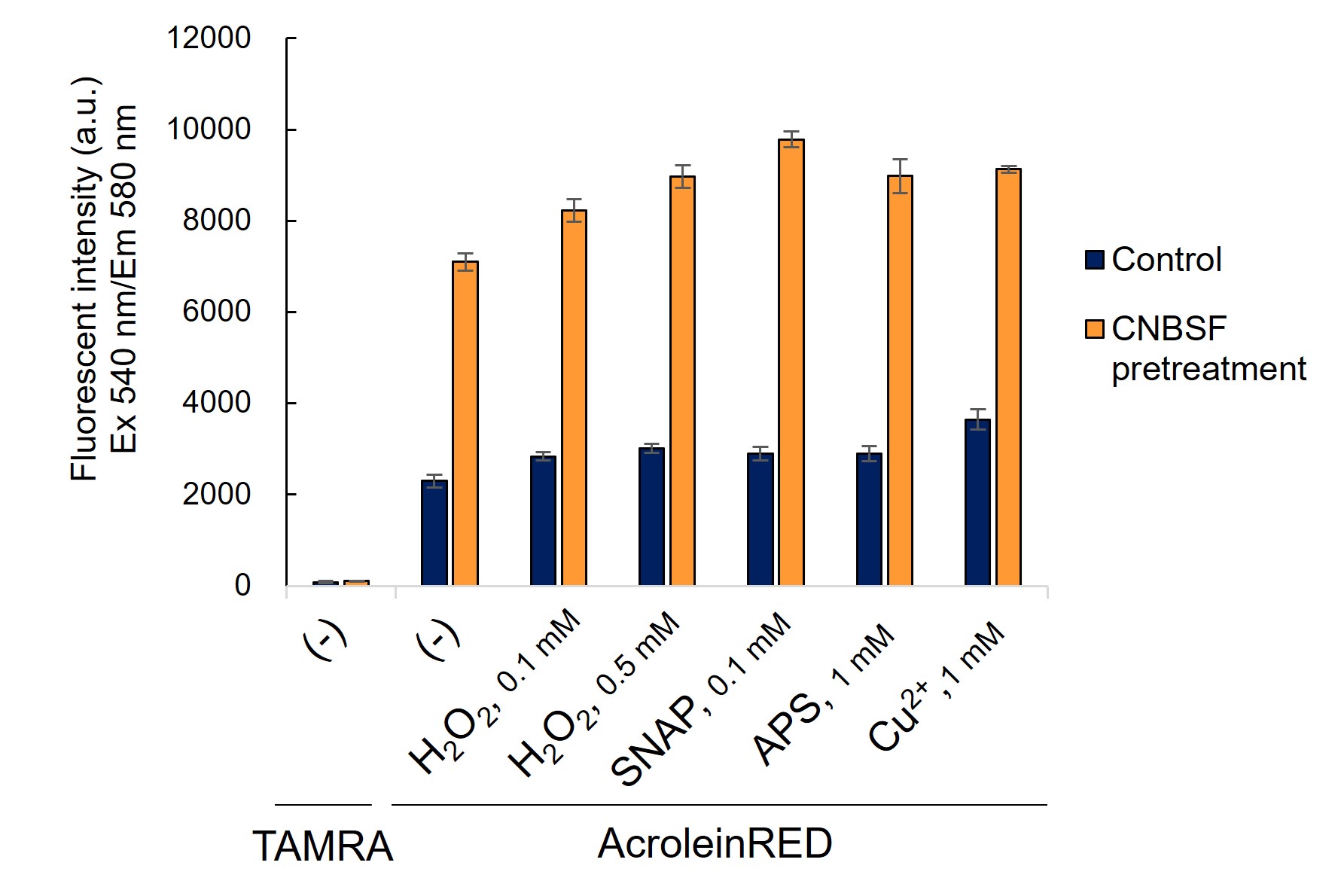Potent Irreversible GST Inhibitor CNBSF
Date:November 06 2020Web Page No:90001

Funakoshi Co.,Ltd.
CNBSF (2-Chloro-5-Nitrobenzen Sulfonyl Fluoride) is an irreversible inhibitor for glutathione S-transferases (GSTs). CNBSF directly binds to GSTs and inactivates their enzymatic activity. Compared with conventional reversible inhibitors, CNBSF could inhibit GST activity for long term.
| DMSO | CNBSF | ||
|
CellFluor™ GST (GST activity) |
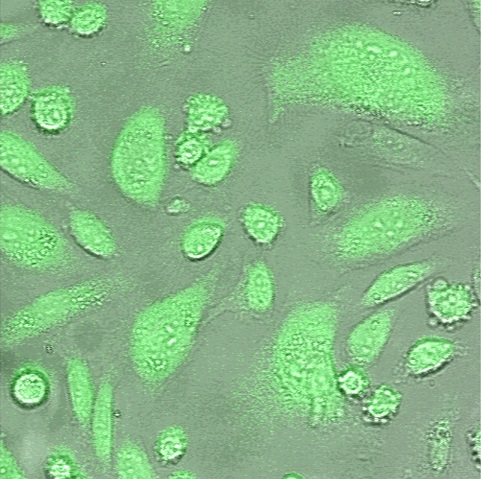
|

|
|
|---|---|---|---|
Inhibition of enzymatic activity of intracellular GST by CNBSF
After treatment of CNBSF to CHO cells to inhibit intracellular GST activities, remaining GST activities in the cells were measured by ☞ CellFluor™ GST, a fluorescence probe for GST in cells. CNBSF dramatically suppressed the fluorescent signal from cells.
GST and its Inhibitors
Function of GSTs
Glutathione S-Transferase (GSTs) are widely conserved in nature from bacteria to plants and animals. In human, over 20 members are identified and classified into three categories: cytosolic, mitochondrial, and membranebound microsomal members. GSTs are phase-II detoxification enzymes and commonly play an important role in detoxification of hydrophobic and electrophilic compounds including endogenous toxic metabolites or xenobiotics by conjugating with glutathione (GSH) to produce glutathione-conjugate (GS-conjugates). Generally, GSTs have two types of substrate-binding site, called G-site and H-site, for GSH and hydrophobic substrate (xenobiotics), respectively. When GSTs bind to GSH as the first substrate, GSTs catalyze and stabilize thiol group of GSH as thiolate anion. Once hydrophobic and electrophilic xenobiotics bind to GSTs as the second substrate, GSTs transfer them to GSH to form GS-conjugates. GS-conjugates are released from GSTs and quickly exported to extracellular space by multidrug resistance-associated protein (MRP) transporters. Through the above processes, GSTs detoxify toxic compounds.

Mechanism of GST action in cells
As many studies suggested expression level of GSTs are significantly increased in cancer cells, GSTs are considered as anticancer drug-resistant enzymes in malignant cancer cells through the neutralization of drugs. Inhibition of GST activities is one of the promising strategies to improve drug efficiency in cancer cells. Some GST inhibitors have been developed so far, however, conventional inhibitors including ethacrynic acid (EA), a representative GST inhibitor, were based on the competition with GSH. In general, competitive inhibitors are usually reversible and not sufficient in cells because of high concentration around mM order of GSH in cells. Although several irreversible inhibitors were also discovered and show potent inhibition in vitro, these compounds have low membrane-permeability and are not good at live cell experiments. To overcome conventional problems, highly membrane-permeable and irreversible inhibitors are desired.
Novel Strategy for Irreversible GST Inhibition
2-chloro-5-nitrobenzensulfonyl fluoride (CNBSF) is a novel type of irreversible GST inhibitor reported in 2019 1. CNBSF is membrane-permeability and capable of entering into cytosol. Once CNBSF incorporated into cell, GSTs catch CNBSF in H-site as a hydrophobic xenobiotics. Subsequently GSTs convert CNBSF to GS-conjugated CNBSF, called GS-5NBSF. In the case of human GSTP1, a member of π-type GST, Tyr108 residue in human GSTP1 quickly reacts with sulfonyl fluoride group of GS-5NBSF, fluoride anion was leaved, and form covalent bound between GST and substrate. In the result of above scheme, GSTs covalently bound inhibitor-complex are inactivated.
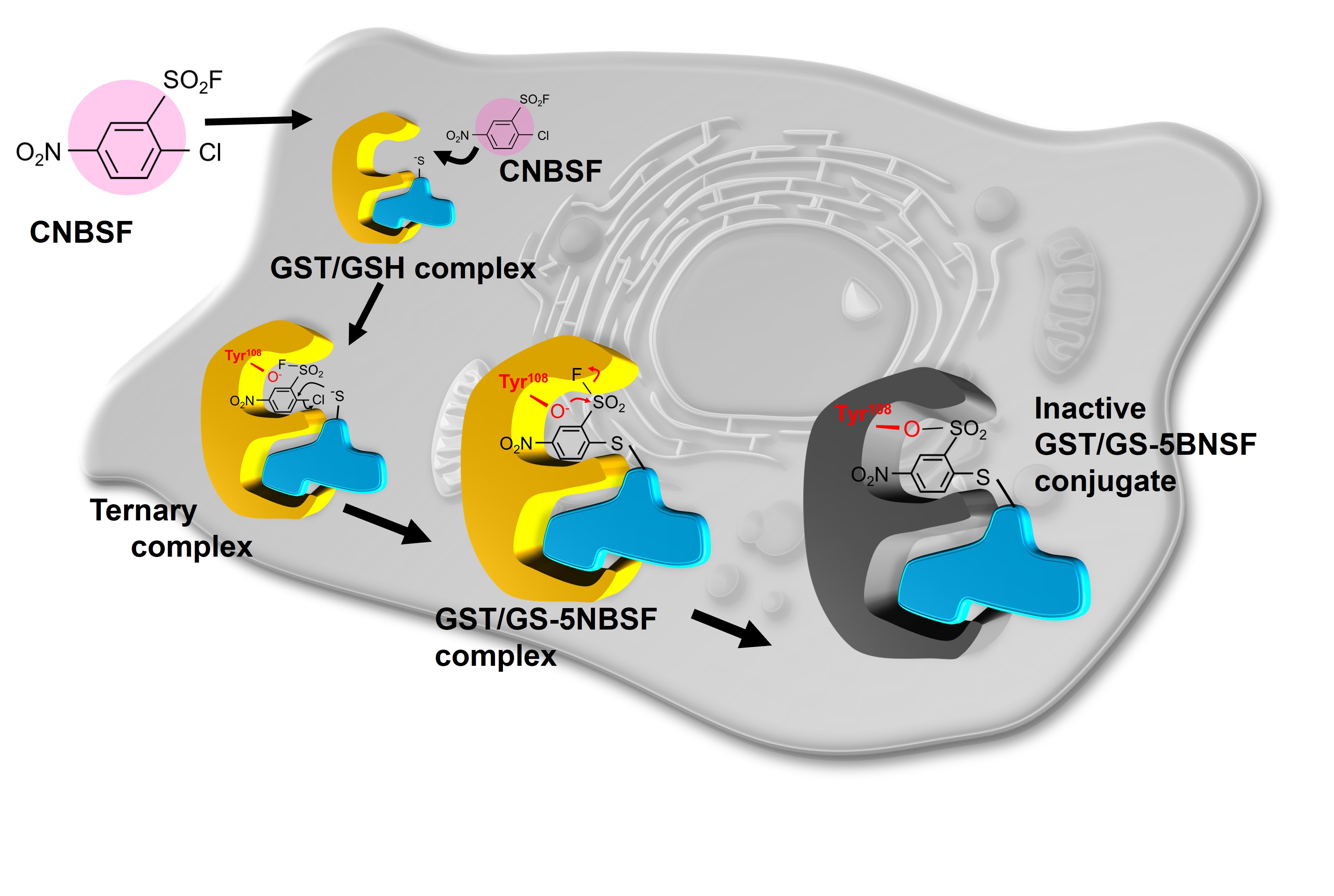
Mechanism of GST inhibition by CNSBF
Principle
Proposed Reaction Mechanism of CNBSF to GSTs
Features
- CNBSF is a membrane-permeable compound and can be used in live cell experiments. For in vitro assay, addition of GSH is essentially required.
- CNBSF directly binds to the catalytic site of GSTs and inactivates GST function for long time. Compatible with both in vitro and in cellulo assay.
- Cytosolic GSTs including GSTα, GSTμ, GSTπ, GSTω, GSTθ and GSTζ were experimentally validated targets of CNBSF *.
*Note : Membran-bound GSTs are not validated at the moment. - Conversion of CNBSF to GS-5NBSF in cells is experimentally validated by mass spectrometry 1.
- In combination with ☞ CellFluor™ GST, a cell-based GST activity assay reagent, GST inhibitory activity in living cells can be quantitatively evaluated.
- CNBSF is a pro-drug of GST inhibitor. By being added to GSH by GST in the cell, it functions as a GST inhibitor (GS-5NBSF).
Note for Experimental Setting
Application Data
- ☞ Broad Inhibition Activity for Cytosolic GST Members
- ☞ Irreversible Inhibition activity in vitro
- ☞ Irreversible Inhibition activity in cellulo
- ☞ Quantification of Inhibitory Activity of CNBSF in cellulo
- ☞ Comparison of Intracellular GST Inhibition Between CNBSF and Rthacrynic acid (EA) in cellulo
- ☞ Estimation of Recovery Time of GST Expression
- ☞ CNBSF Promoted Production of Lipid-peroxidation (LPO) Downstream Metabolites
Broad Inhibition Activity for Cytosolic GST Members
Irreversible Inhibition activity in vitro
Irreversible Inhibition activity in cellulo
Quantification of Inhibitory Activity of CNBSF in cellulo
Comparison of Intracellular GST Inhibition Between CNBSF and Rthacrynic acid (EA) in cellulo
Estimation of Recovery Time of GST Expression
CNBSF Promoted Production of Lipid-peroxidation (LPO) Downstream Metabolites
Reference
- Shishido, Y., et al., "A Covalent Inhibitor for Glutathione S-Transferase Pi (GSTP1-1) in Human Cells." ChemBioChem, 20(7)、900~905 (2019). [PMID:30548113]
Product information
[Date : January 10 2026 00:10]
| Detail | Product Name | Product Code | Supplier | Size | Price | ||||||||||||||||||||||||||||||
|---|---|---|---|---|---|---|---|---|---|---|---|---|---|---|---|---|---|---|---|---|---|---|---|---|---|---|---|---|---|---|---|---|---|---|---|
|
CNBSF, Irreversible GST Inhibitor DatasheetThis may not be the latest data sheet. |
FDV-0031 | FNAFunakoshi Co.,Ltd. | 10 mg | $350 | |||||||||||||||||||||||||||||||
|
|
|
||||||||||||||||||||||||||||||||||
[Date : January 10 2026 00:10]
CNBSF, Irreversible GST Inhibitor
DatasheetThis may not be the latest data sheet.
- Product Code: FDV-0031
- Supplier: FNA
- Size: 10mg
- Price: $350
| Description |
CNBSF is A potent irreversible GST inhibitor. Compared with conventional reversible inhibitors, CNBSF could inhibit GST activity for long term in living cells. |
||
|---|---|---|---|
| Storage | -20°C | CAS | 3829-23-0 |
| Link | |||
CONTACT
export@funakoshi.co.jp
- ※Prices on our website are for your reference only. Please inquire your distributor for your prices.
- ※Please note that Product Information or Price may change without notice.

